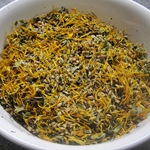Aromatherapy has been used for hundreds of years, without the use of the fancy name. Generation after generation of homemakers prided themselves in creating the most fragrant and visually appealing decor to beautify their homes and provide relief for minor ailments, from headache and anxiety to insomnia and soothing cranky babies.
I will present just a few wonderful herbal home recipes. They are very easy to make and use things you probably already have around the house. Treat yourself to these very affordable indulgences, after all, it's the little things...
May they bring you comfort and relaxation, restful sleep and relief from bad dreams, worrisome thoughts and evil memories.
The herbal pillow (or dream pillow, as some call it)
In olden times, entire mattresses were made from aromatic herbs to induce peaceful sleep and keep away bugs and critters. The herbal pillows also served a medicinal purpose: they doubled as an air freshener and mild antiseptic to provide relief to people recovering from long illnesses. Nowadays the much reduced version of the herbal pillow is small enough to slip in the back of your pillow case (typically around 5"x8" in size). It is usually made from cotton or muslin fabric and it should be smooth and flat.
Besides the fabric you will need:
- aromatic herbs of your choice (rose petals, lavender, hops, and chamomile are usually soothing and soporific)
- a few drops of essential oil to enhance the fragrances
- a fixative (usually orris root, it keeps the fragrance longer)
- filler (buckwheat, hops or plain cotton)
The proportion of filler to herbs is 2/1. Mix everything together well in a bowl, not forgetting to add a few drops of essential oil. Fill the pillowcase and sow the fourth seam. If you would like to know what is in my bowl - mint, basil, calendula, chamomile, goji berries and mint oil.
Place the dream pillow in a plastic baggie for 24 hours to give the scents some time to blend together. Enjoy.
If you replace the muslin with terry cloth (any colorful towel will do) and the filler with sponge, the mix makes for a wonderful bath pillow.
Place the herb mix and rolled oats in a cheesecloth baggie and drop it in the bathtub for an delightful bath tea. (Aromatic oils are a plus!)
The dried herb fragrant sachet
Featured above, it can be hung in your closet, slipped between linen sheets or placed in the drier (which fills the whole house with delightful aroma on laundry day).
What to mix is up to your preferences and available items, but classic sachets generally include rose, violet, verbena, jasmine, lavender and mint.
For a spicy twist try dried citrus peel, cinnamon sticks, vanilla beans, and cloves. The little baggie above is filled with apple cinnamon potpourri: dried apple, pear and strawberry slices, cinnamon sticks, cloves, vanilla, and dried crab apples. It's a very welcoming scent for the upcoming holidays.
The eye pillow
Pretty much the same as the dream pillow, only smaller and using oats, hops or buckwheat as a filler. The weight of the pillow, combined with the aromatic oil, usually lavender, provides relief from insomnia and headaches.
For the little ones
A tiny sachet filled with lavender, chamomile and dill somewhere in proximity of the baby's crib will help the little one fall asleep easier. The name "dill" is derived from a word that actually means "to lull to sleep".
The clove apple
Choose a hard fragrant red winter apple; starting at the blossom end, stick cloves in it until the whole surface is covered, with the exception of the equator, where the ribbon will go. Roll it in a mixture of half orris root, half cinnamon, with a pinch of clove. Wrap it in tissue paper and set it in a warm place to dry for 10 days. After ten days it should have shrunk and dried. Tie the ribbon around it and place it in your kitchen, bathroom or closet, or offer as a gift.
And last but not least, don't forget that any mixture that contains cedar chips or lavender will repel moths and keep your favorite cashmere sweaters free of holes.
Tuesday, November 16, 2010
Subscribe to:
Post Comments (Atom)
the art of waiting
You walk along the garden path one morning, look around and wonder where did it all come from. Naturally, you planted them all, or nearly all, with a few pleasant surprises here and there of self-sown perennials that sprung out from under annual growies before you got to notice them. Otherwise, though, the tall, stately beauties surrounding you are always taking you by surprise, because the first lesson in humility that is served to obstinate gardeners is the unwillingness of living things to develop according to your plans. They have their own internal clocks, their own environmental sensitivities and a completely different relationship with time than you.
So, those lupines that you planted and thought dead sprung up on you two years later, after you planted cosmos over the following year, which self-seeded, and now both plants are gracefully mixing together in a fluff of stringy and palmed leaves, taking over an entire portion of your garden that you were intending for a completely different purpose this year. Or the snapdragons whose seeds you spread evenly over an area, but they decided to all come out bundled together to the left of the patch, leaving the rest of the dirt barren. Or the lily-of-the-valley that you tried to start from roots in the same spot for three years in a row, and now it decided to come out all at the same time and completely take over.
Maybe you were planning, but your garden begs to differ. And when the garden and the gardener have different opinions, the garden usually wins.
The struggling plant that you moved because you needed the space and didn't feel like throwing away now thrives in its new location with a vigor beyond expectations. Sun loving plants keep blooming in the shade behind the house, in a place that, of course, is not a showy feature of your garden. After a while, the oddities and surprises of your garden become familiar and dear to you, like an old friend's little idiosyncrasies warm up your heart after you haven't seen her in a while. A sense of peace descends upon the wiser gardener, a sense of acceptance that in this dialogue with nature, nature has something to say back to you.
If those plants that you failed to recognize when you transferred them outdoors and planted them at the front of the flower bed turned out to be tomatoes, or if the sun garden you neatly organized according to height and flowering season exploded into a jumbled jungle of healthy growth, or if the miniature zinnias developed into four foot tall tree-like structures, or if all those tens of berries you saw on your strawberry plants were gone the second they turned slightly ripe because squirrels and rabbits believed in sharing, enjoy it, allow it, embrace it.
If gardening only taught me one thing it would be the art of waiting. If you have enough patience and time, things kinda turn out the way you planned, sort of, eventually.
your private outdoors
Sitting at the table under the tree canopy, a book in one hand, the other hand mindlessly rubbing your temples, you lose track of time. The splotches of light filtered through the branches above move slowly opposite the sun path, while the day merges into evening. The light becomes gentler, more tired, almost horizontal. Around you two full walls, one half wall, a tree for a roof, and a balcony: your private outdoors. Noises come and go, the chirping of birds, the passing cars, people chatting while walking their dogs, the syncopated rhythm of joggers, the soft rubbery noise of bicycle wheels.
The words on the page start fading as the evening shadow descends into the night, the contours are less precise, the contrast becomes nonexistent. Your cat comes around rubbing against your leg to remind you of dinner. The kids go in and out of the house abruptly, slamming doors, running down stairs and giggling plenty. Night flowering plants release their fragrance in the warmth of the day's end, and as light becomes more scarce, the sounds and scents intensify. The cat settles down in your lap, purring.
Eerie little blue solar powered garden lights dot the darkened contours of the plant masses, and you discern more than you see the familiar garden path, the lilac bush, the archway above the gate. White flowers look like reversed shadows in the headlights of passing cars. The heavy summer night air, thick with humid fragrance, slowly cools down into a breeze.



No comments:
Post a Comment